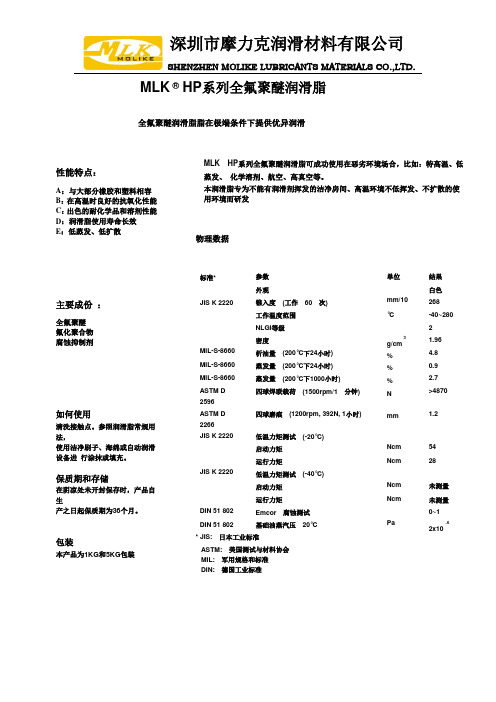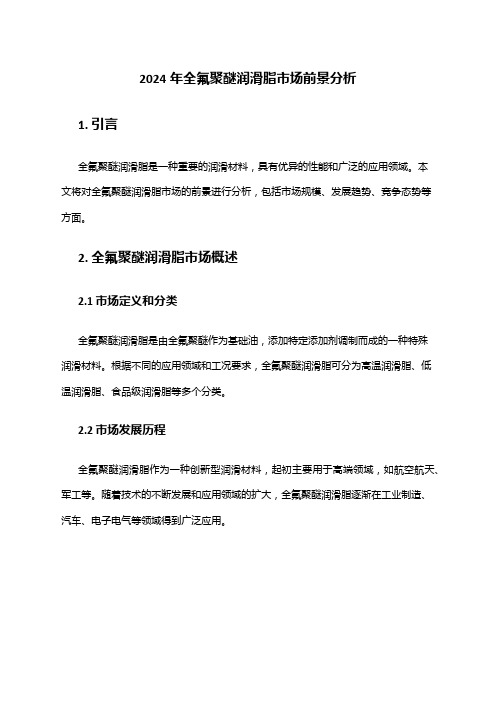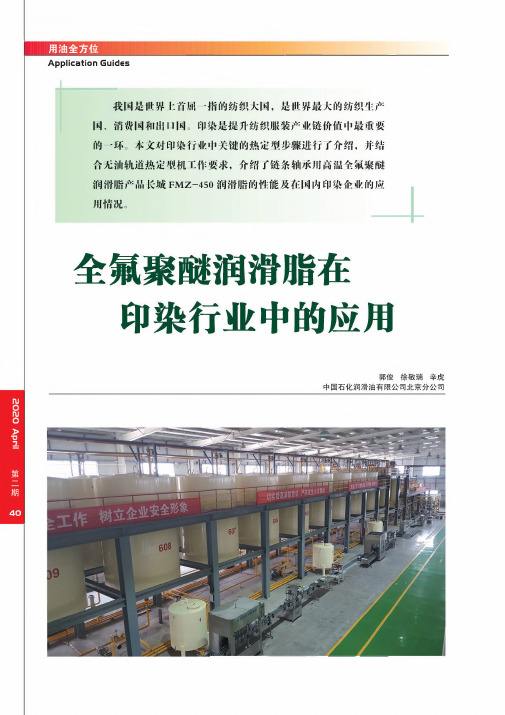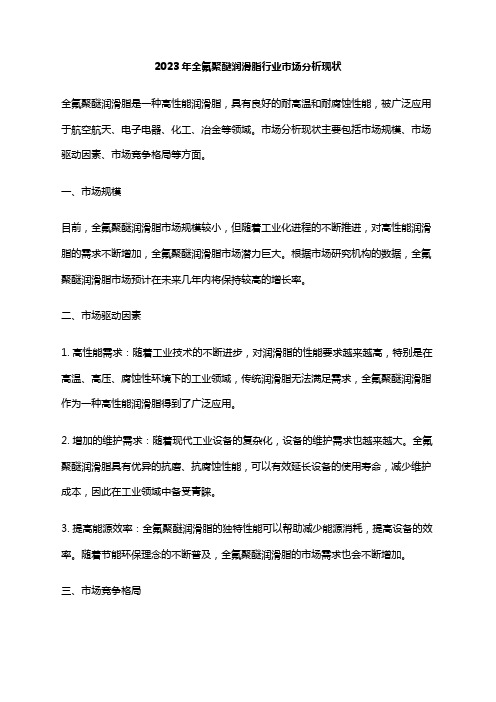全氟聚醚润滑脂
2023年全氟聚醚润滑脂行业市场研究报告

2023年全氟聚醚润滑脂行业市场研究报告全氟聚醚润滑脂是一种高性能特种润滑脂,具有较高的耐高温性能和化学稳定性,广泛应用于航空、航天、电子、光电等领域。
本文将对全氟聚醚润滑脂行业市场进行研究,分析其市场规模、发展趋势和竞争格局。
一、市场规模全氟聚醚润滑脂行业市场规模在过去几年中呈现较快增长。
根据市场研究数据,2019年全球全氟聚醚润滑脂市场规模约为XX亿元,预计到2025年将达到XX亿元,年均增速为XX%。
市场规模的增长主要得益于航空、航天、电子等行业的发展以及对高性能特种润滑脂的需求增加。
二、发展趋势1. 技术升级和创新。
全氟聚醚润滑脂行业将不断推出新产品和新技术,提升其耐高温性能和化学稳定性。
例如,研发具有更高耐高温性能和更长使用寿命的全氟聚醚润滑脂,以满足航空航天领域对高温和极端环境下工作的要求。
2. 市场区域格局调整。
全氟聚醚润滑脂市场主要集中在发达国家和地区,如美国、欧洲和日本等。
但亚太地区经济发展迅速,全氟聚醚润滑脂市场前景广阔。
未来几年,亚太地区将成为全氟聚醚润滑脂行业的增长引擎。
3. 应用领域拓展。
随着科技进步和新兴产业的发展,全氟聚醚润滑脂的应用领域正在不断拓展。
除了传统的航空航天、电子、光电等领域,全氟聚醚润滑脂还可以应用于新能源汽车、医疗设备、工业机械等领域,为行业发展注入新动力。
三、竞争格局目前,全氟聚醚润滑脂行业市场竞争激烈,市场主要由几家大型企业垄断。
这些企业在产品技术研发、市场拓展和品牌建设方面相对具有优势。
此外,全氟聚醚润滑脂是一种高科技产品,生产过程中需要掌握先进的生产工艺和质量管理体系,这也限制了新进入者的进入门槛。
然而,随着市场需求的增加和技术进步,更多的企业开始关注全氟聚醚润滑脂行业。
新进入者通过技术创新、产品差异化等方式打破了市场垄断,给市场带来了更多的选择。
此外,与大型企业相比,中小型企业具有灵活性和快速响应市场的优势,有望在市场竞争中获得一席之地。
综上所述,全氟聚醚润滑脂行业市场具有较大的发展潜力,在技术升级和创新、市场区域格局调整和应用领域拓展等方面呈现出积极的发展趋势。
d型全氟聚醚用途

d型全氟聚醚用途
全氟聚醚主要用于高端润滑油脂和特种化合物改性,在航空航天、电子、化工、机械和医药等领域得到广泛应用。
以D型全氟聚醚为例,其具体用途如下:
- 在印染行业中,全氟聚醚润滑脂能够有效保护链条在高温(200-220℃)下的润滑。
- 在精密仪器领域,利用全氟聚醚型润滑喷剂可以形成一层均匀的润滑薄膜,具有不沾灰、低扭矩、耐高低温、不析油和消音等特性。
- 在大型聚烯烃挤压造粒机组中,全氟聚醚润滑脂能够满足润滑剂的要求,不干结、不流失,并具有良好的载重能力。
- 在打印机中,全氟聚醚润滑脂可以替代矿物油润滑脂,具有更宽的使用温度范围,能够实现长期高效的润滑防护。
全氟聚醚还具有耐腐蚀、材料相容性好和化学惰性等特点,因此在其他领域也有新的应用研究。
摩力克HP-300润滑脂的性能参数

摩力克HP-300润滑脂性能参数品牌;道康宁molykote润滑脂型号;HP-300润滑脂类型;全氟聚醚润滑脂,在极端恶劣的条件下提供卓越的性能典型应用;适于极端温度范围、高真空条件,如半导体行业各种滑动和滚动轴承、泵和风扇轴承,以及用于化学和石化工业中的装料设备中性能;基础油的低蒸汽压·耐化学品性能·耐高温/低温性能·对多数塑料和橡胶具有耐受性·USDA H1物理/化学数据颜色白色组份全氟聚醚,PTFE增稠剂,耐热抗腐蚀剂稠度,密度,粘度稠度,NLGI级2工作锥入度mm/10265-29520℃时密度g/ml 1.96基础油粘度,40℃mm2/s160工作温度,℃-65~+250,短期280滴点,℃无低温力矩测试,-40℃起始启动力矩N cm11运转20分钟后N cm 3.6承裁能力,耐磨,使用寿命四球试验焊联载荷N3300400N载荷下磨痕mm 1.1耐久性水冲淋损失(38ºC,1小时)%0氧气压降(99℃,100小时)蒸汽压力,基油20℃torr4×10-10SKF-EmCor-方法腐蚀程度4分油量(200℃/24小时)%8.0蒸发率(200℃/1000小时)%1应用方法;清洁接触表面,用刷子、刮刀、注脂枪或润滑装置上油,不雅与其它油脂混合。
由于塑料品种很多,在最终使用之前应用指定的材料和所选择的润滑油进行相容性和性能试验。
包装;喷罐:180ml盒装:100g,500g保质期和储存;在20℃以下未开封保存时,产品自生产之日起保质期为36个月。
全氟聚醚高温润滑脂

高温润滑脂使用中低粘度全氟聚醚制作而成,性能出色,而且不溶于水及大多数溶剂,几乎可以与任何工程塑料弹性体搭配使用;其出色的成膜、承载能力和润滑性能成膜能力是普通润滑剂的3倍以上。
全氟聚醚高温轴承润滑脂比瑟奴 B.GREASE-19(FH) ,全氟聚醚(Perfluoropolyethers,缩写为PFPE)是一种常温下为液体的合成聚合物;PFPE具有较高的热稳定性和氧化稳定性以及良好的化学惰性和绝缘性质。
分子量较大的PFPE还具有低挥发性、较宽的液体温度范围及优异的粘枯度—温度特性。
此外,PFPE聚合物的主要物理化学性质还包括:检测稳定性、生物惰性、低表面能,良好的润滑性及与塑料、金属和人造橡胶的相容性等。
全氟聚醚润滑脂作为一种常用的润滑介质和现有的润滑油润滑相比具有优异的稳定性、抗氧化性、机械安定性、粘附性、极压耐磨性以及密封性等特点,适合应用于对润滑介质运动精度、承载能力、极压性质、转速以及使用寿命较长的机械设备的润滑部位。
随着工业现代化的不断发展机械设备等需要润滑部位对于润滑脂的使用要求越来越高,对润滑脂的使用耐温性能也是提出了更高的要求。
现存的高温润滑脂大多存在在高温条件下的软化、分油、干裂、熔化、挥发、硬化等行为导致润.全氟聚醚的主链是由—CF2—O—CF 2—这样的醚链构成,与—CF2CF2CF2—的全氟烯烃链不同,它具有可挠曲性,玻璃化温度低,共液体温度范围(凝固点到沸点)极宽。
另一方面由于氟元素具有较强吸电子效应而使聚合物不显醚的性能,所以具有很好的耐热性,化学稳定性、氧化安定性和完全不燃性。
Pseinu(比瑟奴) B.GREASE-19(FH) 全氟聚醚润滑脂采用全氟聚醚油,具有直链结构,聚四氟乙烯(PTFE)稠化,使用(pseinu)的独特技术开发,并添加抗腐蚀剂配以特殊的聚合物精制而成的。
它具有优良的热和化学稳定性和惰性。
此全氟聚醚润滑脂专用于高温、高速、高负载、化学腐蚀等恶劣环境中的轴承、齿轮以及要求终身润滑的部件,可以很好解决高温下油脂流失、滴落、结焦、积碳和产品磨损等系列润滑难题,保证润滑部位能在高温下长期正常工作。
全氟聚醚润滑脂

SHENZHEN MOLIKE LUBRICANTS MATERIALS CO.,LTD.性能特点:A :与大部分橡胶和塑料相容B :在高温时良好的抗氧化性能C :出色的耐化学品和溶剂性能D :润滑脂使用寿命长效E :低蒸发、低扩散主要成份 :全氟聚醚氟化聚合物腐蚀抑制剂如何使用清洗接触点。
参照润滑脂常规用法,使用洁净刷子、海绵或自动润滑设备进 行涂抹或填充。
保质期和存储在阴凉处未开封保存时,产品自生产之日起保质期为36个月。
包装本产品为1KG 和5KG 包装MLK ® HP 系列全氟聚醚润滑脂全氟聚醚润滑脂脂在极端条件下提供优异润滑MLK HP 系列全氟聚醚润滑脂可成功使用在恶劣环境场合,比如:特高温、低蒸发、 化学溶剂、航空、高真空等。
本润滑脂专为不能有润滑剂挥发的洁净房间、高温环境不低挥发、不扩散的使用环境而研发 物理数据 标准* JIS K 2220 单位 MIL-S-8660 MIL-S-8660 MIL-S-8660 ASTM D 2596 ASTM D 2266 JIS K 2220 JIS K 2220 DIN 51 802 DIN 51 802 参数 外观 锥入度 (工作 60 次) 工作温度范围 NLGI 等级 密度 析油量 (200°C 下24小时) 蒸发量 (200°C 下24小时) 蒸发量 (200°C 下1000小时) 四球焊联载荷 (1500rpm/1 分钟) 四球磨痕 (1200rpm, 392N, 1小时) 低温力矩测试 (-20°C) 启动力矩 运行力矩 低温力矩测试 (-40°C) 启动力矩 运行力矩 E mcor 腐蚀测试 基础油蒸汽压 20°C mm/10 °C 3 g/cm % % % N mm 结果 白色 268 -40~280 2 1.96 4.8 0.9 2.7 >4870 1.2 Ncm Ncm 54 28 Ncm Ncm Pa 未测量 未测量 0~1 -6 2x10 * JIS: 日本工业标准 ASTM: 美国测试与材料协会 MIL: 军用规格和标准DIN: 德国工业标准。
2024年全氟聚醚润滑脂市场前景分析

2024年全氟聚醚润滑脂市场前景分析1. 引言全氟聚醚润滑脂是一种重要的润滑材料,具有优异的性能和广泛的应用领域。
本文将对全氟聚醚润滑脂市场的前景进行分析,包括市场规模、发展趋势、竞争态势等方面。
2. 全氟聚醚润滑脂市场概述2.1 市场定义和分类全氟聚醚润滑脂是由全氟聚醚作为基础油,添加特定添加剂调制而成的一种特殊润滑材料。
根据不同的应用领域和工况要求,全氟聚醚润滑脂可分为高温润滑脂、低温润滑脂、食品级润滑脂等多个分类。
2.2 市场发展历程全氟聚醚润滑脂作为一种创新型润滑材料,起初主要用于高端领域,如航空航天、军工等。
随着技术的不断发展和应用领域的扩大,全氟聚醚润滑脂逐渐在工业制造、汽车、电子电气等领域得到广泛应用。
3. 全氟聚醚润滑脂市场规模与趋势3.1 市场规模根据市场研究数据显示,全氟聚醚润滑脂市场在过去几年里呈现出稳定增长的态势。
其中,工业制造和汽车行业是全氟聚醚润滑脂的主要应用领域。
3.2 市场趋势随着环保意识的提高,全氟聚醚润滑脂因其优异的环境适应性和替代性而受到越来越多的关注。
同时,在特殊工况下,对润滑脂性能的要求也越来越高,这将驱动全氟聚醚润滑脂市场的进一步发展。
4. 全氟聚醚润滑脂市场竞争态势4.1 主要厂商及产品全氟聚醚润滑脂市场存在较多的厂商竞争,主要包括A公司、B公司、C公司等多家知名企业。
这些企业通过不断创新、技术提升和产品优化来争夺市场份额。
4.2 竞争策略为了在激烈的市场竞争中脱颖而出,全氟聚醚润滑脂企业不断加强研发投入,提升产品质量和性能。
同时,企业还积极拓展市场渠道,加强营销推广,提高品牌知名度和影响力。
5. 全氟聚醚润滑脂市场发展机遇与挑战5.1 机遇全氟聚醚润滑脂具有优异的耐高温、耐腐蚀、抗磨损等特性,适用于各种复杂工况下的润滑需求。
随着工业制造、汽车、航天等领域的快速发展,全氟聚醚润滑脂市场将迎来更广阔的机遇。
5.2 挑战全氟聚醚润滑脂市场面临着一些挑战,包括技术门槛、市场竞争、成本压力等。
全氟聚醚润滑脂在印染行业中的应用

Application Guides我国是世界上首屈一指的纺织大国,是世界最大的纺织生产国、消费国和出「1国。
印染是提升纺织服装产业链价值中最重要的一环。
本文对印染行业中关键的热定型步骤进行了介绍,并结合无油轨道热定型机工作要求,介绍了链条轴承用高温全氟聚碰润滑脂产品长城FMZ-450润滑脂的性能及在国内印染企业的应用情况。
全氟聚醸润滑脂在印染行业中的应用郭俊徐敬瑞辛虎中国石化润滑油有限公司北京分公司Application Guides我国是世界上首屈一指的纺织大国,是世界最大的纺织生产国、消费国和出口国。
据统计,2000—2018年,我国纤维加工总量占全球比重从25%提高到58%,出口份额占全球比重从15%提高到39%左右⑴。
未来几年,随着经济的稳定增长和居民收入及消费能力的不断提高,我国纺织行业的市场潜力和需求前景将更加广阔,整体仍将保持较快增长。
根据我国《纺织工业“十三五”发展规划》所确定的目标,“十三五”期间,我国规模以上纺织企业工业增加值年均增速将保持在6%〜7%,从“纺织大国”不断向“纺织强国”迈进。
纺织行业包括化纤纺丝、织造、到印染后整理及服装等一系列完整产业链条,其中印染是提升纺织产业链附加值的关键环节,而印染热定型是织物后整理过程中一个极其重要的工序,主要针对织物印染前处理后出现的经向伸长、纬向收缩、纬纱歪斜的问题,它使织物得到稳定的尺寸结构和颜色性能⑵。
热定型工艺是利用高温(如180〜220r)、高速气流对织物进行烘干熨烫,使织物获得稳定的尺寸,然后迅速冷却降温的过程。
所 以印染定型机链条需在长时间、高温度下不停运转。
为了使定型机链条得到更好的润滑保护和更长的使用寿命,润滑油脂的选择就变得尤为重要⑶。
无油轨道定型机是热定型机型中的一种,是国内外先进技术经验和使用厂家的织物工艺要求设计配制最理想的轨道导轨,由布针两用铁、单用铁、单用针板座、针板、链条、石墨条、钢制滑板等组织而成,链条之间用滚动轴承连接,广泛适用在纯棉、涤棉混纺、化纤平幅机织物。
2023年全氟聚醚润滑脂行业市场分析现状

2023年全氟聚醚润滑脂行业市场分析现状全氟聚醚润滑脂是一种高性能润滑脂,具有良好的耐高温和耐腐蚀性能,被广泛应用于航空航天、电子电器、化工、冶金等领域。
市场分析现状主要包括市场规模、市场驱动因素、市场竞争格局等方面。
一、市场规模目前,全氟聚醚润滑脂市场规模较小,但随着工业化进程的不断推进,对高性能润滑脂的需求不断增加,全氟聚醚润滑脂市场潜力巨大。
根据市场研究机构的数据,全氟聚醚润滑脂市场预计在未来几年内将保持较高的增长率。
二、市场驱动因素1. 高性能需求:随着工业技术的不断进步,对润滑脂的性能要求越来越高,特别是在高温、高压、腐蚀性环境下的工业领域,传统润滑脂无法满足需求,全氟聚醚润滑脂作为一种高性能润滑脂得到了广泛应用。
2. 增加的维护需求:随着现代工业设备的复杂化,设备的维护需求也越来越大。
全氟聚醚润滑脂具有优异的抗磨、抗腐蚀性能,可以有效延长设备的使用寿命,减少维护成本,因此在工业领域中备受青睐。
3. 提高能源效率:全氟聚醚润滑脂的独特性能可以帮助减少能源消耗,提高设备的效率。
随着节能环保理念的不断普及,全氟聚醚润滑脂的市场需求也会不断增加。
三、市场竞争格局目前,全氟聚醚润滑脂市场竞争较为激烈,主要包括国内外知名润滑脂生产企业。
国内企业主要分布在一线、二线城市,产品品质和市场口碑较好;而国外企业则具备技术优势和行业经验,品牌影响力较大。
市场竞争主要体现在产品品质、技术创新、价格竞争和市场营销等方面。
总结起来,全氟聚醚润滑脂市场具有巨大的潜力和发展空间。
随着工业化进程的加快,对高性能润滑脂的需求将不断增加,全氟聚醚润滑脂作为一种高性能产品将有望在市场中占据重要地位。
但同时面临激烈的市场竞争,企业需要积极创新,提升产品质量和技术水平,增强竞争力。
此外,加强市场营销和渠道建设也是企业的关键任务,为产品开拓更广阔的市场。
2023年全氟聚醚润滑脂行业市场规模分析

2023年全氟聚醚润滑脂行业市场规模分析全氟聚醚润滑脂是一种高性能润滑材料,具有很高的耐高温、耐腐蚀、耐久性和抗磨损等特性,在广泛的应用场合中扮演着重要的角色。
本文基于市场需求和产业背景等因素,分析全氟聚醚润滑脂行业市场规模的变化及趋势。
一、市场规模变化全氟聚醚润滑脂作为高性能润滑材料,其市场规模会受到产业背景的影响。
从全球范围看,随着工业化的推进和工业技术的发展,全氟聚醚润滑脂的市场需求逐渐递增。
而在中国市场方面,随着中国经济快速发展和工业结构优化,高性能润滑材料的应用领域不断拓展。
据公开数据显示,近五年全氟聚醚润滑脂在中国市场的销售额逐年攀升。
据市场调研机构统计,2018年全球全氟聚醚润滑脂市场规模约为10亿美元,其中亚太地区是全氟聚醚润滑脂的最大消费市场之一。
在中国市场,全氟聚醚润滑脂主要应用于电子电器、航空航天、汽车等领域,市场规模逐年上升。
2019年,全氟聚醚润滑脂市场规模达到15亿元,同比增长23%。
预计未来五年,中国全氟聚醚润滑脂市场将保持稳步增长。
二、市场规模趋势(一)高技术机器制造领域需求增长全氟聚醚润滑脂在现代机器制造中占有重要地位,随着机器制造业的高速发展,润滑脂的市场需求也将逐步增长。
尤其是在高技术机器制造领域,由于对机器性能和稳定性的要求越来越高,对高性能润滑材料的需求也越来越大。
因此,在未来五年内,全氟聚醚润滑脂市场规模将保持增长。
(二)新能源车市场崛起新能源车市场正在崛起,随着新能源汽车行业的发展,全氟聚醚润滑脂也将得到应用。
全氟聚醚润滑脂的高温耐久性和低温摩擦性能,适用于新能源汽车的关键部件,如电机和传动系统等。
行业预测,随着新能源汽车市场的不断拓展,未来五年内全氟聚醚润滑脂市场规模将大幅增长。
(三)环保节能需求推动市场发展随着环保意识的加强和能源消耗问题的日益严重,全氟聚醚润滑脂在节能环保领域将得到广泛应用。
相对于传统润滑材料,全氟聚醚润滑脂在使用过程中不会产生污染物和其他有害物质,并且能够有效降低能源消耗。
全氟聚醚润滑脂

DERILL全氟聚醚润滑脂M331概述M331-C2超高温轴承润滑脂采用全氟聚醚合成基础油和特殊的氟素复合稠化剂,并配以精心挑选的、高科技的添加剂组合研制而成。
具有高滴点和显著的机械稳定性,能承载高负荷、高冲击负载;其抗水、抗腐蚀能力都很强,是专门为高温条件下摩擦副研制的超高温润滑脂。
M331-C2超高温轴承润滑脂采用了全氟聚醚合成基础油和特别配制的氟素复合稠化剂,因而具有极高的滴点、优异的抗高温氧化性能和高温润滑性能,全氟聚醚合成基础油本身具有很多优异的特性,高温条件下不燃烧、不碳化,使其在高温条件下最大化的保持结构的稳定性,基础油优异的高温氧化安定性,使其润滑脂即使在超过200度的温度下,也能表现出优良的特性;全氟聚醚合成基础油具有高强度油膜与突出的抗腐蚀性能,不与强氧化剂、强酸、强碱有机溶剂等发生化学反应,使其润滑脂即使在恶劣的环境下也最大的延长润滑脂的使用寿命,使其润滑脂的蒸发损失与其他类型的润滑脂相比保持最低,因而广泛应用于航天、航空以及高真空条件下的轴承;氟素复合稠化剂具有较低的摩擦系数、优良的抗腐蚀性能,配以全氟聚醚合成基础油,使其润滑脂具有其他类型润滑脂无比的优异的性能。
全氟聚醚合成基础油精心挑选且专有的添加剂组合能够提供卓越的性能,比如出色的高温抗磨保护,卓越的抗氧化性,以及抗锈蚀与防腐蚀性能。
即使在非常苛刻和极端高温的条件下,也能够提供紧急的润滑,为抢修赢得时间。
减少停工时间和维修费用,实现更高的生产力。
性能特点极佳的高温氧化安定性及长的轴承寿命出众的超高温性能,在极端的温度条件下也能提供紧急润滑热稳定性良好,降温至常温后,可恢复原来的结构卓越的抗氧化,使用寿命长突出的抗挤压耐磨性能不含铅,氯及氮化物极好的化学惰性,不与强氧化剂、强酸、强碱、有机溶剂等物质发生化学反应不燃烧,无残留物典型应用可满足各工业轴承制造商指定的各种要求多用途超高温润滑脂,特别为工作在200度以上的各种机械设备轴承、链条等,如加热炉设备,煅烧设备等高温环境里的低速、中速轴承(如拉伸拉幅机、热熔风机、热定型机、高温染色缸等)钢厂热轧锟轴承、砑光锟轴承重型机械、拖车转向轮各种苛刻或是重负荷工况条件的工业设备典型案例一汽大众烤漆线链条上海大众烤漆线链条红光染整热定型机链条等。
全氟聚醚润滑油、全氟聚醚润滑脂PFPE特性与应用

全氟聚醚润滑油、全氟聚醚润滑脂PFPE特性与应用
QWOLBER 苛沃博全氟聚醚润滑油PFPE特性与应用
全氟聚醚(PFPE)是由氟原子、碳原子和氧原子组成的长链含氟聚合物。
由于氟原子和氧原子与碳原子紧密结合,PFPE非常惰性。
PFPEs是高或宽温度范围应用的最佳选择,苛刻或腐蚀性的化学环境,高真空,抗辐射或其他高性能润滑油应用。
PFPE流体特性:
不易燃的
优异的热稳定性和氧化稳定性
极宽的温度范围能力
高粘度指数
惰性于液态和气态氧(LOX和GOX)
无与伦比的耐化学和耐溶剂性(包括水和蒸汽)
与大多数金属、塑料、弹性体和橡胶兼容且不发生反应;不会引起脆化,或这些材料的膨胀。
极低挥发性(低蒸发损失)
无毒(许多等级都是食品级的能力)和环保安全
优秀的电阻
应用的行业:
汽车
国防、航空和航天
食品设备
医疗和关键应用
石油和天然气
工艺设备
纸和起皱
半导体和电子产品
PFPE在极端条件下的优异性能:
核工业
电器元件
纺织品,包括染色
轴承,阀门,屏蔽流体应用和仪器
真空系统(包括扩散泵和涡轮泵)
化工制造包括:氧、氯、UF6、酸及其他腐蚀剂。
是高性能润滑脂的优良基础油
汽车制动系统等部件
总而言之:PFPE具有安全性能,使用寿命长。
全氟聚醚润滑脂

PFPE Lubricating GreaseDr. Martin Schweigkofler, Dr. Stefan Grundei, Dr. Wallace Zhang, Jocelyn ZhaoDr. Thomas Kilthau, Dr. Martin Schmidt-Amelunxen, Dr. Stefan Seemeyer,Klüber Lubrication München SE & Co. KGKlüber Lubrication Industries (Shanghai) Co.,Ltd.AbstractThe paper discloses lubricating greases which contain perfluoropolyether. Composition1.PFPE oilLubrication greases use base oils like mineral oils, native oils, and synthetic hydrocarbon oils, such as PAO, alkylated naphthalines, alkylated phenylethers, silicone oils, ester oils, polyglycols and so on. All these base oils contain hydrogen bonded to Carbon, i.e. CH, CH2 and CH3 groups. These base oils cannot be used at very high temperatures and can react with different chemicals like oxidizing materials. Some of them are not sufficiently stable against hydrolysis or nucleophilic substances, e.g. amines. These hydrocarbon oils can also have a strong undesired impact on seal materials or components made out of plastics such as POM, Polyamides and PEEK.These weakness can be minimized or avoided by using Perfluoropolyether (PFPE) of the general formulaX´O(CF2O)m(CF2CF2O)n[CF2CF(CF3)O]s [CF(CF3)O]u(CF2CF2CF2O)v X (I)As base oil or part of the base oil.In drawing (I) the perfluoroalkyloxy units can be distributed randomly throughout the chain. The subscripts m, n, s, u, and v can independently be 0 to maximal 200. The molecular weight of the material for example determined by the ratio of the terminal groups compared to the internal groups via NMR analysis can be up to 20000 u.The kinematic viscosity of the perfluoropolyether can be between 5 and 2000 mm²/sec at 40°C, more preferable between 15 and 1300 mm²/sec.The pour point of the perfluoropolyether can be as low as – 80°C.The end groups X and X´ can be can be short chain perfluoroalkyl groups like CF3, C2F5, C3F7,fluorine groups is substituted by a hydrocarbon group, hydrogen, hydroxyl groups, amine groups, amid groups, carbonyl groups, or other functional groups.2.PFPE based greaseTypical PFPE lubricating grease is composed by base oil and thickener. In some PFPE grease, one or more additives are added as well.The NLGI class of the greases can be between 000 and 5, preferred between 0 and 3, even more preferred between 1 and 3.a)Base oili.Pure PFPE base oilThe perfluoropolyether can be used alone or in mixtures of two or more of the possibletypes as indicated by formula I.ii.Hybrid base oilThe base oil can be also composed by one or more type perfluoropolyether, mixed with one or more from the following type oil: mineral oils, synthetic oils or native oils. Typical ratio of PFPE to the other oils is in the range of 1:10 to 10:1.The synthetic oils are selected from an ester of an aliphatic or aromatic di-, tri- ortetracarboxylic acid with one or a mixture of C7 to C22 alcohols, a polyphenyl ether oralkylated diphenyl ether, an ester of trimethylolpropane, pentaerythritol or dipentaerythritol with aliphatic C7 to C22 carboxylic acids, C18 dimer acid esters with C7 to C22 alcohols, complex esters, individual components or in any mixtures. In addition, the synthetic oil may beselected from poly-α-olefins, metallocene catalyzed PAO, alkylated naphthalenes, alkylated benzenes, polyglycols, silicone oils, or alkylated diphenylether.The mineral oils may be selected from paraffin-basic, naphthene-basic, aromatichydrocracking oils; gas to liquid (GTL) liquids, GTL refers to a gas to liquid method anddescribes a method for production of fuel from natural gas. Natural gas is converted bysteam reforming to synthesis gas, which is then converted by Fischer-Tropsch synthesis to fuels by using catalysts. The catalysts and the process conditions control the type of fuel, i.e., whether gasoline, kerosene, diesel or oils are produced. Coal may also be used as a rawmaterial in the same way by the coal to liquid method (CTL) and biomass may be used as a raw material in the biomass to liquid (BTL) method.Triglycerides from animal/vegetable sources that have been upgraded by known methods such as hydrogenation may be used as native oils. The especially preferred triglyceride oils are genetically modified triglyceride oils with high oleic acid content. Typical vegetable oils used therein and genetically modified or cultured having a high oil content include safflower oil, corn oil, canola oil, sunflower oil, soybean oil, linseed oil, peanut oil, lesquerella oil,meadowfoam oil and palm oil. The native oils might further be processed e.g. polymerization processes.b)thickenerThe thickener material used can be fluorinated polymers like polytetrafluoroethylene (PTFE), oxides like silica, organic carbonic acid salts, boron nitride, carbides like silicon carbide, poly- or diurea compounds, polyimides or polyamidimides, melamine cyanurates, graphite, carbon black, carbon nanotubes, molybdates, phosphates.The PTFE used can be produced by polymerization of tetrafluorethylene in suspension or dispersion. To adjust the particle size and the polymer chain length processes like grinding, thermal treatment or irradiation processes can be used. PTFE powders treated as indicated above are e.g. known as micronized PTFE, but also dispersion processes leading to lowmolecular weight PTFE are known. These PTFE products can be used without the processes indicated above.Typical molecular weights are between 10000 g/mol and 10exp8 g/mol, preferred between 100000 g/mol and 10exp7 g/mol.Also recycling of PTFE by processes as indicated above can produce PTFE powders that can be used for thickeners of lubricants.The organic acids can be saturated or unsaturated, branched or unbranched, mono or di or tri or polyacids containing 6 to 25 carbon acids and their mixtures like stearic acid,hydroxystearic acid, benzoic acid, oleic acid, acelaic acid, sebacic acids, behenic acid, amid groups containing acids. Amid group containing acids can for example be prepared byreacting primary or secondary aliphatic amines with di-acids or di-esters of aliphatic oraromatic carbonic acids.The cations of the organic acid salts can be lithium, sodium, potassium, magnesium, calcium, aluminum, barium or zinc.The urea compounds are reaction products of aliphatic or aromatic mono or diisocyanatemixtures. Examples for suitable urea compounds are reaction products of diisocyanates, preferably 2,4-diisocyanatotoluene, 2,6-diisocyanatotoluene,4,4′-diisocyanatodiphenylmethane, 2,4′-diisocyanatodiphenylmethane,4,4′-diisocyanatodiphenyl, 4,4′-diisocyanato-3,3′-dimethyldiphenyl,4,4′-diisocyanato-3,3′-dimethylphenylmethane which may be used individually or incombination, with an amine of the general formula R′2N—R or a diamine of the generalformula R′2N—R—N—R′2 where R is an aryl, alkyl or alkylene radical with 2 to 22 carbon atoms and R′ is identical to or different from a hydrogen, an alkyl, alkylene or aryl radical, or with mixtures of amines and diamines.These thickener materials can be used alone or in combination.The particle size of the thickener is usually below 100µ, preferred below 20 µm.The amount of thickener material is below 50 %, preferred below 40 %c)AdditivesAdditionally additives can be used to improve the EP, anti-corrosion properties, frictionproperties, wear properties, oxidation resistance properties. The additives can be materials soluble in PFPE oils or insoluble materials.PFPE soluble materials comprise one or more functional groups based on phosphates,phosphazenes, triazines, aromatic nitro compounds, acid amides, carbonic acid derivatives, ammonium salts and linking groups or end groups consisting of PFPE moieties like groups (II) and (III),CbF(2b+1)O(CF2O)m(CF2CF2O)n[CF2CF(CF3)O]s [CF(CF3)O]u(CF2CF2CF2O)v- (II)-O(CF2O)m(CF2CF2O)n[CF2CF(CF3)O]s [CF(CF3)O]u(CF2CF2CF2O)v- (III).PFPE insoluble additives can be metal molybdates, metal phosphates, salt of organic acids, nitrite salts, metal sulfides like molybdenum disulfide or zinc sulfide, oxides like silicates, hexagonal boron nitride, metal oxides or hydroxides or hydrogen carbonates and theirmixtures.The cations in the mentioned oxides, hydroxides, hydrogen carbonates and carbonates can be derived from alkaline or earth alkaline metals like sodium, lithium, magnesium, potassium, calcium.Further additives which are not soluble in PFPE can be arylamine derivatives, phenolderivatives, metal salts of organic carbonic or sulfonic acids or phosphoric acids ofThe additives can for example be chosen from the group comprising butyl hydroxy toluene, dialkyl diphenylamines, styrolized diphenylamines, alkylated phenyl-alpha-naphthylamines, polymeric trimethyl dihydroquinoline, sulfurized fatty acid esters, diphenyl cresyl phosphate, amine-neutralized phosphates, alkylated and non-alkylated triaryl phosphates, alkylated and non-alkylated triaryl thiophosphates, zinc-dialkyl dithiophosphates, carbamates, thiocarbamates, zinc-dithiocarbamates, dimercaptothiadiazole, succinic acid semi-ester, calcium sulfonates, benzotriazole derivatives, K-pentaborates, Na-thiosulfates, andNa-pyrophosphates.The amount of additives in the grease can be up to 15 % by weight, more preferable less than 10 % by weight.ApplicationThe lubricant formulations can be used in technical components like bearings, gears, chains, screws, valves, spindles, actuators, armatures, electrical contacts, ropes, combustion and electrical motors, seals, pneumatic or hydraulic devices, compressors, brakes.Bearing industry, automotive industry, automotive supplier industry, foil producing industry, wood panel industry, food processing industry, cement industry, mining industry, marine industry, convey or …..Typical formulation:Sample I1.PFPE 83% (kin.vis. @ 40°C 100 mm2/s)2.PTFE 17% D50 < 20 µmSample II1.PFPE80% (kin.vis. @ 40°C 100 mm2/s)2.PTFE 20% D50 < 20 µmSample III1.PFPE 75% (kin.vis. @ 40°C 200 mm2/s)2.PTFE 20% D50 < 20 µm3.BN 5%Sample IV1.PFPE 73% (kin.vis. @ 40°C 400 mm2/s)2.PTFE 25% D50 < 20 µm3.ZnS 2%Sample V1.PFPE 76% (kin.vis. @ 40°C 1000 mm2/s)2.PTFE 22% D50 < 20 µm3.ZnS 2%Sample VI1.PFPE 42% (kin.vis. @ 40°C 400 mm2/s)2.Trimellitate ester, 45% (kin.vis. @ 40°C 70 mm2/s)3.Urea thickener, 8%4.Alkyl phenyl amine, 2%5.Alkyl phenol, 2%6.ZnDDP, 1%Sample VII1.PFPE 37% (kin.vis. @ 40°C 400 mm2/s)2.PAO, 45% (kin.vis. @ 40°C 400 mm2/s)3.Lithium 12OH-stearate, 8%4.Lithium sebacate, 2%5.Alkyl phenyl amine, 2%6.Alkyl phenol, 2%8.Calcium sulphonate 2%Reference1.PAO, 75% (kin.vis. @ 40°C 400 mm2/s)2.Urea thickener, 8%3.Alkyl phenyl amine, 2%4.Alkyl phenol, 2%5.ZnDDP, 1%6.Calcium sulphonate 2%Table 1. Test result of PFPE greasePage | 8全氟聚醚润滑脂Dr. Martin Schweigkofler, Dr. Stefan Grundei, Dr. Wallace Zhang, Jocelyn ZhaoDr. Thomas Kilthau, Dr. Martin Schmidt-Amelunxen, Dr. Stefan Seemeyer,Klüber Lubrication München SE & Co. KG克鲁勃润滑产品(上海)有限公司摘要本文章公开了含有全氟聚醚的润滑脂。
- 1、下载文档前请自行甄别文档内容的完整性,平台不提供额外的编辑、内容补充、找答案等附加服务。
- 2、"仅部分预览"的文档,不可在线预览部分如存在完整性等问题,可反馈申请退款(可完整预览的文档不适用该条件!)。
- 3、如文档侵犯您的权益,请联系客服反馈,我们会尽快为您处理(人工客服工作时间:9:00-18:30)。
PFPE Lubricating GreaseDr. Martin Schweigkofler, Dr. Stefan Grundei, Dr. Wallace Zhang, Jocelyn ZhaoDr. Thomas Kilthau, Dr. Martin Schmidt-Amelunxen, Dr. Stefan Seemeyer,Klüber Lubrication München SE & Co. KGKlüber Lubrication Industries (Shanghai) Co.,Ltd.AbstractThe paper discloses lubricating greases which contain perfluoropolyether. Composition1.PFPE oilLubrication greases use base oils like mineral oils, native oils, and synthetic hydrocarbon oils, such as PAO, alkylated naphthalines, alkylated phenylethers, silicone oils, ester oils, polyglycols and so on. All these base oils contain hydrogen bonded to Carbon, i.e. CH, CH2 and CH3 groups. These base oils cannot be used at very high temperatures and can react with different chemicals like oxidizing materials. Some of them are not sufficiently stable against hydrolysis or nucleophilic substances, e.g. amines. These hydrocarbon oils can also have a strong undesired impact on seal materials or components made out of plastics such as POM, Polyamides and PEEK.These weakness can be minimized or avoided by using Perfluoropolyether (PFPE) of the general formulaX´O(CF2O)m(CF2CF2O)n[CF2CF(CF3)O]s [CF(CF3)O]u(CF2CF2CF2O)v X (I)As base oil or part of the base oil.In drawing (I) the perfluoroalkyloxy units can be distributed randomly throughout the chain. The subscripts m, n, s, u, and v can independently be 0 to maximal 200. The molecular weight of the material for example determined by the ratio of the terminal groups compared to the internal groups via NMR analysis can be up to 20000 u.The kinematic viscosity of the perfluoropolyether can be between 5 and 2000 mm²/sec at 40°C, more preferable between 15 and 1300 mm²/sec.The pour point of the perfluoropolyether can be as low as – 80°C.The end groups X and X´ can be can be short chain perfluoroalkyl groups like CF3, C2F5, C3F7,fluorine groups is substituted by a hydrocarbon group, hydrogen, hydroxyl groups, amine groups, amid groups, carbonyl groups, or other functional groups.2.PFPE based greaseTypical PFPE lubricating grease is composed by base oil and thickener. In some PFPE grease, one or more additives are added as well.The NLGI class of the greases can be between 000 and 5, preferred between 0 and 3, even more preferred between 1 and 3.a)Base oili.Pure PFPE base oilThe perfluoropolyether can be used alone or in mixtures of two or more of the possibletypes as indicated by formula I.ii.Hybrid base oilThe base oil can be also composed by one or more type perfluoropolyether, mixed with one or more from the following type oil: mineral oils, synthetic oils or native oils. Typical ratio of PFPE to the other oils is in the range of 1:10 to 10:1.The synthetic oils are selected from an ester of an aliphatic or aromatic di-, tri- ortetracarboxylic acid with one or a mixture of C7 to C22 alcohols, a polyphenyl ether oralkylated diphenyl ether, an ester of trimethylolpropane, pentaerythritol or dipentaerythritol with aliphatic C7 to C22 carboxylic acids, C18 dimer acid esters with C7 to C22 alcohols, complex esters, individual components or in any mixtures. In addition, the synthetic oil may beselected from poly-α-olefins, metallocene catalyzed PAO, alkylated naphthalenes, alkylated benzenes, polyglycols, silicone oils, or alkylated diphenylether.The mineral oils may be selected from paraffin-basic, naphthene-basic, aromatichydrocracking oils; gas to liquid (GTL) liquids, GTL refers to a gas to liquid method anddescribes a method for production of fuel from natural gas. Natural gas is converted bysteam reforming to synthesis gas, which is then converted by Fischer-Tropsch synthesis to fuels by using catalysts. The catalysts and the process conditions control the type of fuel, i.e., whether gasoline, kerosene, diesel or oils are produced. Coal may also be used as a rawmaterial in the same way by the coal to liquid method (CTL) and biomass may be used as a raw material in the biomass to liquid (BTL) method.Triglycerides from animal/vegetable sources that have been upgraded by known methods such as hydrogenation may be used as native oils. The especially preferred triglyceride oils are genetically modified triglyceride oils with high oleic acid content. Typical vegetable oils used therein and genetically modified or cultured having a high oil content include safflower oil, corn oil, canola oil, sunflower oil, soybean oil, linseed oil, peanut oil, lesquerella oil,meadowfoam oil and palm oil. The native oils might further be processed e.g. polymerization processes.b)thickenerThe thickener material used can be fluorinated polymers like polytetrafluoroethylene (PTFE), oxides like silica, organic carbonic acid salts, boron nitride, carbides like silicon carbide, poly- or diurea compounds, polyimides or polyamidimides, melamine cyanurates, graphite, carbon black, carbon nanotubes, molybdates, phosphates.The PTFE used can be produced by polymerization of tetrafluorethylene in suspension or dispersion. To adjust the particle size and the polymer chain length processes like grinding, thermal treatment or irradiation processes can be used. PTFE powders treated as indicated above are e.g. known as micronized PTFE, but also dispersion processes leading to lowmolecular weight PTFE are known. These PTFE products can be used without the processes indicated above.Typical molecular weights are between 10000 g/mol and 10exp8 g/mol, preferred between 100000 g/mol and 10exp7 g/mol.Also recycling of PTFE by processes as indicated above can produce PTFE powders that can be used for thickeners of lubricants.The organic acids can be saturated or unsaturated, branched or unbranched, mono or di or tri or polyacids containing 6 to 25 carbon acids and their mixtures like stearic acid,hydroxystearic acid, benzoic acid, oleic acid, acelaic acid, sebacic acids, behenic acid, amid groups containing acids. Amid group containing acids can for example be prepared byreacting primary or secondary aliphatic amines with di-acids or di-esters of aliphatic oraromatic carbonic acids.The cations of the organic acid salts can be lithium, sodium, potassium, magnesium, calcium, aluminum, barium or zinc.The urea compounds are reaction products of aliphatic or aromatic mono or diisocyanatemixtures. Examples for suitable urea compounds are reaction products of diisocyanates, preferably 2,4-diisocyanatotoluene, 2,6-diisocyanatotoluene,4,4′-diisocyanatodiphenylmethane, 2,4′-diisocyanatodiphenylmethane,4,4′-diisocyanatodiphenyl, 4,4′-diisocyanato-3,3′-dimethyldiphenyl,4,4′-diisocyanato-3,3′-dimethylphenylmethane which may be used individually or incombination, with an amine of the general formula R′2N—R or a diamine of the generalformula R′2N—R—N—R′2 where R is an aryl, alkyl or alkylene radical with 2 to 22 carbon atoms and R′ is identical to or different from a hydrogen, an alkyl, alkylene or aryl radical, or with mixtures of amines and diamines.These thickener materials can be used alone or in combination.The particle size of the thickener is usually below 100µ, preferred below 20 µm.The amount of thickener material is below 50 %, preferred below 40 %c)AdditivesAdditionally additives can be used to improve the EP, anti-corrosion properties, frictionproperties, wear properties, oxidation resistance properties. The additives can be materials soluble in PFPE oils or insoluble materials.PFPE soluble materials comprise one or more functional groups based on phosphates,phosphazenes, triazines, aromatic nitro compounds, acid amides, carbonic acid derivatives, ammonium salts and linking groups or end groups consisting of PFPE moieties like groups (II) and (III),CbF(2b+1)O(CF2O)m(CF2CF2O)n[CF2CF(CF3)O]s [CF(CF3)O]u(CF2CF2CF2O)v- (II)-O(CF2O)m(CF2CF2O)n[CF2CF(CF3)O]s [CF(CF3)O]u(CF2CF2CF2O)v- (III).PFPE insoluble additives can be metal molybdates, metal phosphates, salt of organic acids, nitrite salts, metal sulfides like molybdenum disulfide or zinc sulfide, oxides like silicates, hexagonal boron nitride, metal oxides or hydroxides or hydrogen carbonates and theirmixtures.The cations in the mentioned oxides, hydroxides, hydrogen carbonates and carbonates can be derived from alkaline or earth alkaline metals like sodium, lithium, magnesium, potassium, calcium.Further additives which are not soluble in PFPE can be arylamine derivatives, phenolderivatives, metal salts of organic carbonic or sulfonic acids or phosphoric acids ofThe additives can for example be chosen from the group comprising butyl hydroxy toluene, dialkyl diphenylamines, styrolized diphenylamines, alkylated phenyl-alpha-naphthylamines, polymeric trimethyl dihydroquinoline, sulfurized fatty acid esters, diphenyl cresyl phosphate, amine-neutralized phosphates, alkylated and non-alkylated triaryl phosphates, alkylated and non-alkylated triaryl thiophosphates, zinc-dialkyl dithiophosphates, carbamates, thiocarbamates, zinc-dithiocarbamates, dimercaptothiadiazole, succinic acid semi-ester, calcium sulfonates, benzotriazole derivatives, K-pentaborates, Na-thiosulfates, andNa-pyrophosphates.The amount of additives in the grease can be up to 15 % by weight, more preferable less than 10 % by weight.ApplicationThe lubricant formulations can be used in technical components like bearings, gears, chains, screws, valves, spindles, actuators, armatures, electrical contacts, ropes, combustion and electrical motors, seals, pneumatic or hydraulic devices, compressors, brakes.Bearing industry, automotive industry, automotive supplier industry, foil producing industry, wood panel industry, food processing industry, cement industry, mining industry, marine industry, convey or …..Typical formulation:Sample I1.PFPE 83% (kin.vis. @ 40°C 100 mm2/s)2.PTFE 17% D50 < 20 µmSample II1.PFPE80% (kin.vis. @ 40°C 100 mm2/s)2.PTFE 20% D50 < 20 µmSample III1.PFPE 75% (kin.vis. @ 40°C 200 mm2/s)2.PTFE 20% D50 < 20 µm3.BN 5%Sample IV1.PFPE 73% (kin.vis. @ 40°C 400 mm2/s)2.PTFE 25% D50 < 20 µm3.ZnS 2%Sample V1.PFPE 76% (kin.vis. @ 40°C 1000 mm2/s)2.PTFE 22% D50 < 20 µm3.ZnS 2%Sample VI1.PFPE 42% (kin.vis. @ 40°C 400 mm2/s)2.Trimellitate ester, 45% (kin.vis. @ 40°C 70 mm2/s)3.Urea thickener, 8%4.Alkyl phenyl amine, 2%5.Alkyl phenol, 2%6.ZnDDP, 1%Sample VII1.PFPE 37% (kin.vis. @ 40°C 400 mm2/s)2.PAO, 45% (kin.vis. @ 40°C 400 mm2/s)3.Lithium 12OH-stearate, 8%4.Lithium sebacate, 2%5.Alkyl phenyl amine, 2%6.Alkyl phenol, 2%8.Calcium sulphonate 2%Reference1.PAO, 75% (kin.vis. @ 40°C 400 mm2/s)2.Urea thickener, 8%3.Alkyl phenyl amine, 2%4.Alkyl phenol, 2%5.ZnDDP, 1%6.Calcium sulphonate 2%Table 1. Test result of PFPE greasePage | 8全氟聚醚润滑脂Dr. Martin Schweigkofler, Dr. Stefan Grundei, Dr. Wallace Zhang, Jocelyn ZhaoDr. Thomas Kilthau, Dr. Martin Schmidt-Amelunxen, Dr. Stefan Seemeyer,Klüber Lubrication München SE & Co. KG克鲁勃润滑产品(上海)有限公司摘要本文章公开了含有全氟聚醚的润滑脂。
